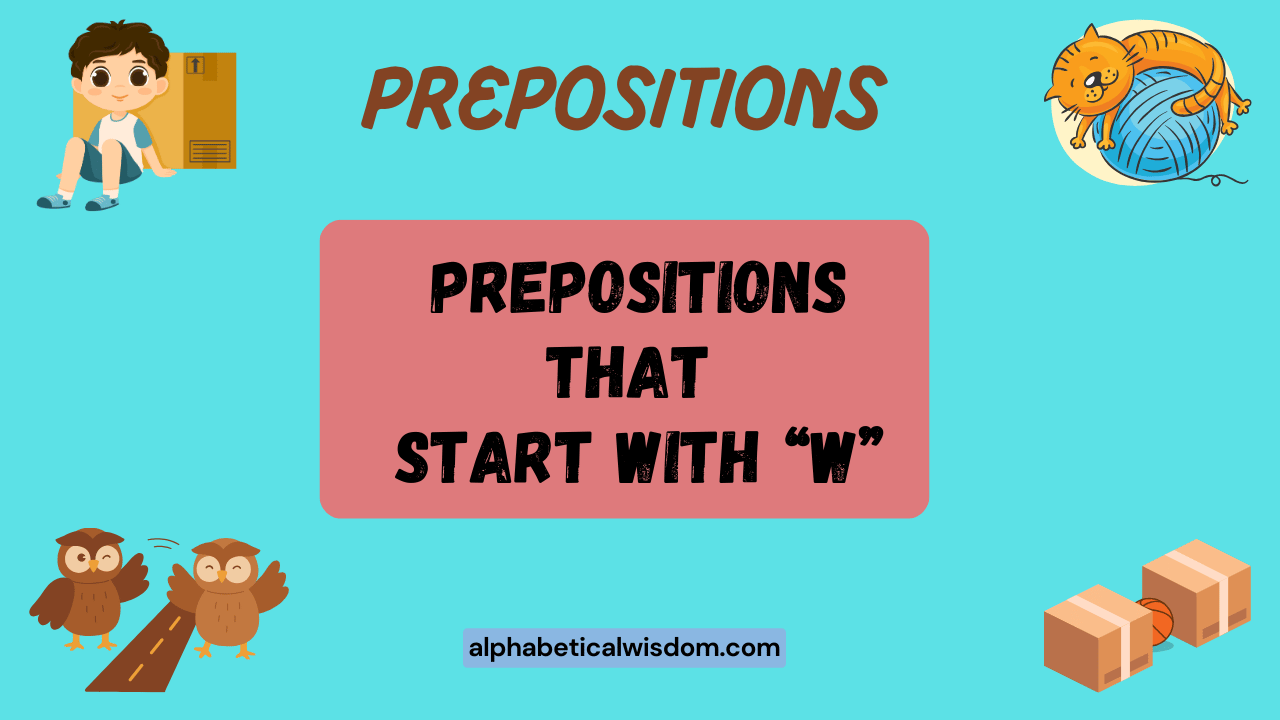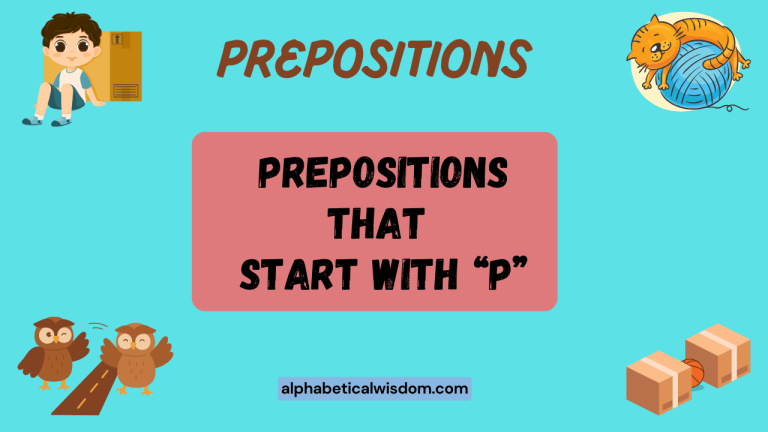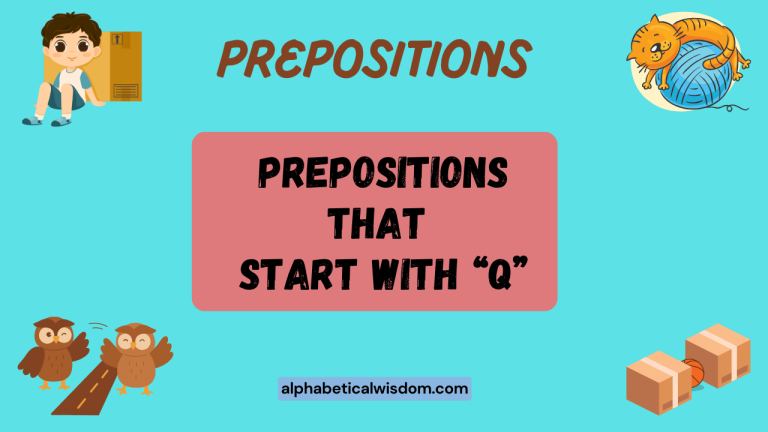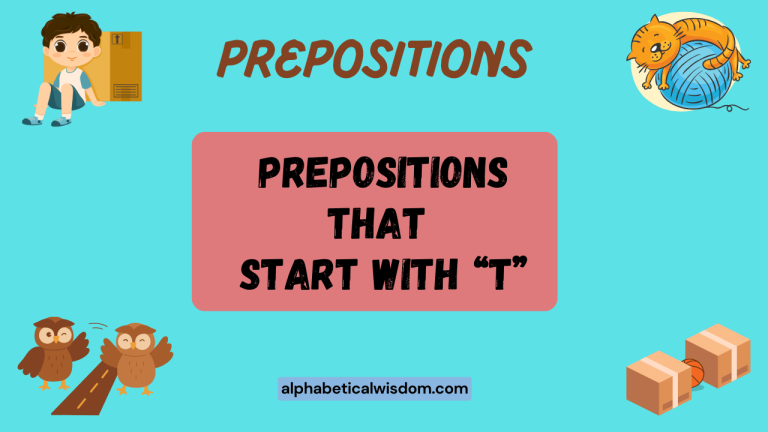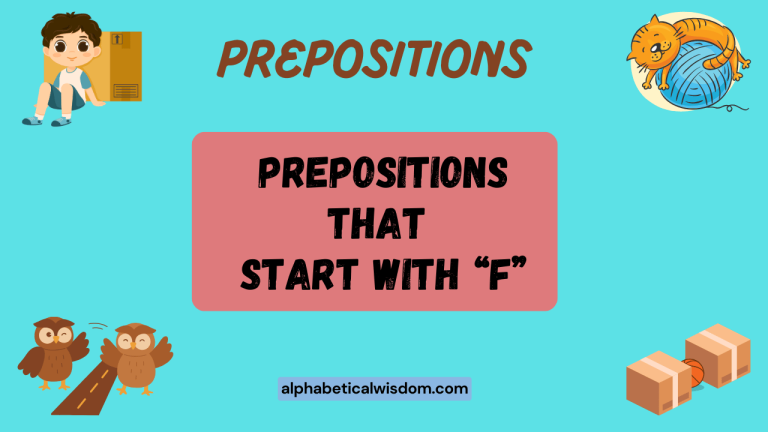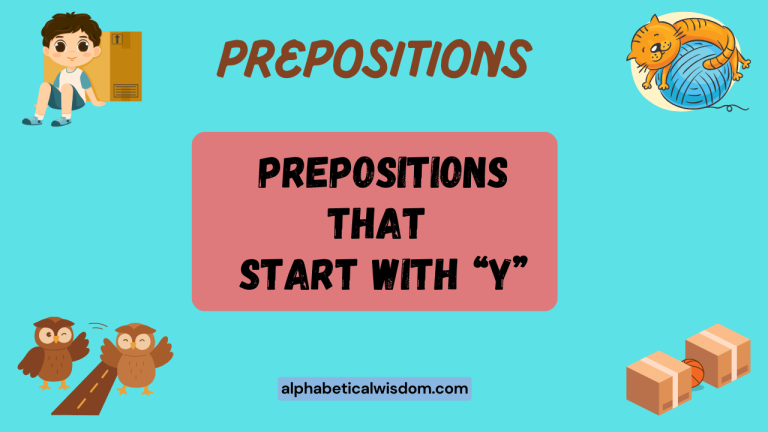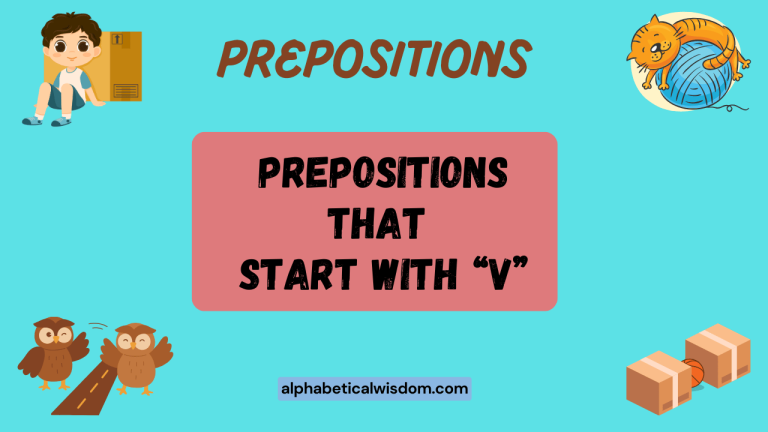Prepositions Starting With ‘W’: Comprehensive Grammar Guide
Mastering prepositions is crucial for achieving fluency and accuracy in English. Prepositions, though small words, play a significant role in connecting nouns, pronouns, and phrases to other parts of a sentence.
This article focuses specifically on prepositions that begin with the letter ‘W,’ providing a detailed explanation of their meanings, usage, and common pitfalls. Whether you’re an ESL learner, a student preparing for exams, or simply someone who wants to refine their grammar skills, this guide will equip you with the knowledge and practice needed to confidently use prepositions starting with ‘W’ in your writing and speech.
Definition of Prepositions
A preposition is a word that connects a noun, pronoun, or noun phrase to other words in a sentence. Prepositions typically indicate location, direction, time, or the relationship between objects or ideas.
They are essential for providing context and clarity in writing and speech. Prepositions usually precede the noun or pronoun, forming what is known as a prepositional phrase.
These phrases act as adjectives or adverbs, modifying other words in the sentence. Understanding prepositions is crucial for constructing grammatically correct and meaningful sentences.
Prepositions can be classified based on their structure and function. Simple prepositions consist of a single word, such as with, within, and without. Compound prepositions are formed by combining two or more words, such as according to or because of. Prepositions of time indicate when something happens (e.g., at, on, in), while prepositions of place describe where something is located (e.g., above, below, beside). Prepositions of direction indicate movement (e.g., to, from, towards). The function of a preposition depends on the context of the sentence and the relationship it establishes between the elements it connects.
The context in which a preposition is used significantly affects its meaning. For example, the preposition with can indicate accompaniment (“I went to the store with my friend”), possession (“The house with the blue door is mine”), or instrument (“She cut the bread with a knife”). Similarly, within can denote a location inside something (“The cat is within the house”) or a time frame (“The project must be completed within a week”). Therefore, it is essential to consider the surrounding words and the overall meaning of the sentence when interpreting the function of a preposition.
Structural Breakdown of Prepositional Phrases
A prepositional phrase consists of a preposition and its object, which is typically a noun or pronoun. The structure of a prepositional phrase is generally: Preposition + (Article) + Noun/Pronoun. For instance, in the phrase “with the dog,” with is the preposition, the is the article, and dog is the noun. The entire phrase acts as a unit, modifying another word or phrase in the sentence.
Prepositional phrases can function as adjectives or adverbs. When a prepositional phrase acts as an adjective, it modifies a noun or pronoun, providing additional information about it. For example, in the sentence “The book on the table is mine,” the phrase “on the table” modifies the noun “book.” When a prepositional phrase acts as an adverb, it modifies a verb, adjective, or another adverb, providing information about manner, time, place, or reason. In the sentence “She walked with confidence,” the phrase “with confidence” modifies the verb “walked,” indicating the manner in which she walked.
The placement of a prepositional phrase in a sentence can affect its meaning and clarity. Generally, it is best to place prepositional phrases as close as possible to the word they modify to avoid ambiguity. For example, the sentence “I saw a dog running in the park with a long tail” could be interpreted as the park having a long tail. To avoid this, it should be rephrased as “I saw a dog with a long tail running in the park.” Proper placement ensures that the intended meaning is clear and unambiguous.
Types and Categories of Prepositions Starting With ‘W’
With
The preposition ‘with’ is a versatile word that indicates accompaniment, possession, instrument, manner, or agreement. It expresses a relationship of association or connection between two or more things. Understanding the different contexts in which ‘with’ can be used is crucial for accurate and effective communication. Its flexibility allows it to convey a wide range of meanings depending on the sentence structure and the surrounding words.
Within
The preposition ‘within’ denotes being inside a boundary, limit, or range. It is commonly used to express location, time, or scope. ‘Within’ implies containment or enclosure, whether physical or abstract. It is often used to set parameters or conditions, indicating that something must occur or exist inside those defined limits. It is more formal than ‘in’ and often suggests a more precise or restricted context.
Without
The preposition ‘without’ indicates the absence or lack of something. It expresses a condition of not having or being deprived of something. ‘Without’ can also convey a sense of being free from or unaffected by something. It is crucial for expressing negative conditions or consequences. Its use can range from describing physical absence to abstract concepts like freedom from worry or pain.
Examples of Prepositions Starting With ‘W’
Examples with ‘With’
The preposition ‘with’ is used in various contexts to indicate accompaniment, possession, instrument, manner, or agreement. The following table provides examples illustrating each of these uses.
| Category | Example Sentence |
|---|---|
| Accompaniment | I went to the movies with my friends. |
| Accompaniment | She arrived at the party with her husband. |
| Accompaniment | The children played happily with their toys. |
| Accompaniment | He walked down the street with his dog. |
| Accompaniment | We had dinner with our neighbors last night. |
| Possession | The house with the red door is for sale. |
| Possession | The girl with the blue eyes is very talented. |
| Possession | The man with the beard is my uncle. |
| Possession | She bought a dress with beautiful embroidery. |
| Possession | He drives a car with leather seats. |
| Instrument | She cut the paper with scissors. |
| Instrument | He opened the bottle with a corkscrew. |
| Instrument | They fixed the car with basic tools. |
| Instrument | She writes her novels with a fountain pen. |
| Instrument | He painted the fence with a brush. |
| Manner | She spoke with confidence. |
| Manner | He approached the task with enthusiasm. |
| Manner | She danced with grace and elegance. |
| Manner | He handled the situation with skill. |
| Manner | She answered the questions with honesty. |
| Agreement | I agree with your proposal. |
| Agreement | She sided with her brother in the argument. |
| Agreement | He concurred with the decision of the committee. |
| Agreement | We are in agreement with the terms of the contract. |
| Agreement | She is aligned with the company’s values. |
Examples with ‘Within’
The preposition ‘within’ is used to indicate being inside a boundary, limit, or range, often relating to location, time, or scope. The examples below illustrate the various contexts in which ‘within’ can be applied.
| Category | Example Sentence |
|---|---|
| Location | The cat is within the house. |
| Location | The documents are stored within the vault. |
| Location | The secret garden is hidden within the walls of the castle. |
| Location | The ancient city lies within the borders of modern-day Greece. |
| Location | The treasure is buried within the island’s dense jungle. |
| Time | The project must be completed within a week. |
| Time | The application should be submitted within 24 hours. |
| Time | The package will arrive within three business days. |
| Time | The results will be available within an hour. |
| Time | The meeting will be held within the next month. |
| Scope | The issue falls within the scope of this investigation. |
| Scope | The decision is within the authority of the manager. |
| Scope | The topic is within the realm of theoretical physics. |
| Scope | The problem is within the domain of computer science. |
| Scope | The solution lies within the boundaries of ethical considerations. |
| Range | The temperature remained within a comfortable range. |
| Range | The price is within our budget. |
| Range | The noise level is within acceptable limits. |
| Range | The error rate is within the specified tolerance. |
| Range | The performance of the system is within expected parameters. |
Examples with ‘Without’
The preposition ‘without’ is used to indicate the absence or lack of something, expressing a condition of not having or being deprived of something. The table below provides various examples of its usage.
| Category | Example Sentence |
|---|---|
| Absence | He left the house without his keys. |
| Absence | She went to the store without her wallet. |
| Absence | They completed the project without any help. |
| Absence | The cake is delicious without frosting. |
| Absence | The movie was enjoyable without special effects. |
| Lack | He lived without money for many years. |
| Lack | She felt lost without direction. |
| Lack | They struggled without resources. |
| Lack | The plant died without water. |
| Lack | The team failed without proper leadership. |
| Deprivation | He was left without food or water. |
| Deprivation | She was stranded without transportation. |
| Deprivation | They were forced to live without electricity. |
| Deprivation | The refugees were without shelter. |
| Deprivation | The prisoner was held without communication. |
| Freedom | She walked without fear. |
| Freedom | He spoke without hesitation. |
| Freedom | They lived without worry. |
| Freedom | She worked without supervision. |
| Freedom | He acted without consulting anyone. |
Usage Rules for Prepositions Starting With ‘W’
Rules for ‘With’
The preposition ‘with’ has several specific rules governing its usage. It is crucial to use ‘with’ correctly to avoid ambiguity and ensure clear communication.
One key rule is to ensure that the object of the preposition ‘with’ is correctly associated with the intended subject or object in the sentence. Misplacement can lead to unintended meanings.
When using ‘with’ to indicate an instrument, ensure that the instrument is the means by which an action is performed. For example, “She wrote the letter with a pen” is correct, but “She wrote the letter with happiness” is incorrect because happiness is not an instrument.
Similarly, when indicating accompaniment, ensure that ‘with’ accurately reflects the relationship of being together or alongside. For instance, “I went to the park with my dog” is correct, but “I went to the park with yesterday” is incorrect because ‘yesterday’ cannot accompany someone.
Another rule involves the use of ‘with’ in idiomatic expressions. Many English idioms use ‘with’ in specific ways, such as “deal with,” “cope with,” and “agree with.” These expressions have fixed meanings and should be used as they are without alteration.
For example, it is correct to say “I need to deal with this problem,” but incorrect to say “I need to deal this problem.” Understanding and memorizing these idiomatic uses is essential for mastering the correct usage of ‘with’.
Rules for ‘Within’
The preposition ‘within’ typically indicates containment or limitation, and its usage is governed by certain rules. It is often used to specify a boundary, either physical or abstract, and implies that something must be inside that boundary.
One important rule is to ensure that ‘within’ is used when expressing a range or limit, especially when referring to time or location. For example, “The package will arrive within three days” is correct, while “The package will arrive in three days” has a slightly different implication, suggesting the package will arrive exactly on the third day.
When using ‘within’ to indicate location, it implies being inside something, whether it’s a physical structure or a defined area. For instance, “The documents are within the safe” suggests that the documents are enclosed inside the safe.
It is generally more formal than ‘in’ and conveys a sense of precision. However, it’s essential to avoid redundancy.
Saying “inside within” is incorrect because ‘within’ already implies being inside.
Another rule involves the context in which ‘within’ is used. It is often used in formal or technical contexts to express precision and limitation.
In legal or official documents, ‘within’ is frequently used to set specific deadlines or boundaries. For example, “The appeal must be filed within 30 days.” In everyday conversation, ‘in’ might be more commonly used, but ‘within’ adds a layer of formality and exactness.
Understanding the context helps in choosing the appropriate preposition for clear and effective communication.
Rules for ‘Without’
The preposition ‘without’ is used to indicate the absence or lack of something, and its usage is subject to specific rules. It is crucial to use ‘without’ correctly to convey the intended meaning of lacking or being free from something.
One primary rule is to ensure that ‘without’ is followed by a noun or noun phrase that represents what is missing or absent. For example, “He left without his keys” is correct, but “He left without to take his keys” is incorrect because ‘to take his keys’ is not a noun phrase.
When using ‘without’ to express a condition of being free from something, ensure that it accurately reflects the absence of that condition. For instance, “She walked without fear” is correct, indicating that she was not afraid.
However, “She walked without afraid” is incorrect because ‘afraid’ is an adjective and not a noun phrase. The correct form would be “She walked without fear.”
Another rule involves avoiding double negatives when using ‘without’. Since ‘without’ already implies a negative condition, adding another negative word can create confusion.
For example, saying “He cannot live without no money” is incorrect because it contains two negatives. The correct way to express this is “He cannot live without money” or “He can live with no money.” Avoiding double negatives ensures clarity and grammatical correctness when using ‘without’.
Common Mistakes with Prepositions Starting With ‘W’
Several common mistakes occur when using prepositions starting with ‘W’. Recognizing and correcting these errors can significantly improve your English grammar.
One frequent mistake is confusing ‘with’ and ‘by’. ‘With’ typically indicates accompaniment or instrument, while ‘by’ often indicates the agent performing an action or proximity.
For instance, “The book was written with John” is incorrect; the correct sentence is “The book was written by John.” Similarly, “I stood with the window” is incorrect; “I stood by the window” is the right usage.
Another common error involves the misuse of ‘within’ and ‘in’. While both prepositions can indicate location or time, ‘within’ implies a boundary or limit, whereas ‘in’ is more general.
For example, “The meeting will start within 10 minutes” is correct, indicating a timeframe. However, saying “The meeting will start in 10 minutes” suggests the meeting will begin exactly after 10 minutes.
Also, avoid using “inside within” as ‘within’ already implies being inside.
A further mistake is using ‘without’ incorrectly to form double negatives. As ‘without’ already conveys a negative condition, adding another negative word can lead to confusion.
For example, “I can’t go without no money” is incorrect; the correct sentence is “I can’t go without money” or “I can go with no money.” Being mindful of these common mistakes and practicing correct usage can help you avoid these errors and enhance your grammatical accuracy.
| Incorrect | Correct | Explanation |
|---|---|---|
| I agree to your proposal. | I agree with your proposal. | ‘Agree’ requires ‘with’ when followed by a proposal or person. |
| The cat is in the house. | The cat is within the house. | ‘Within’ emphasizes containment inside the house. |
| He left without to say goodbye. | He left without saying goodbye. | ‘Without’ should be followed by a gerund or noun phrase. |
| She did it by a knife. | She did it with a knife. | ‘With’ is used to indicate the instrument used to perform an action. |
| The project must finish in a week. | The project must finish within a week. | ‘Within’ indicates a timeframe limit. |
| I can’t live without no hope. | I can’t live without hope. | Avoid double negatives with ‘without’. |
| He stood with the door. | He stood by the door. | ‘By’ indicates proximity or being near. |
| Inside within the box. | Within the box. | Avoid redundancy; ‘within’ already implies being inside. |
| I am agree with you. | I agree with you. | The verb ‘agree’ doesn’t need ‘am’ in this context. |
| She succeeded without hardly trying. | She succeeded without trying hard. | Avoid using adverbs that create a double negative with ‘without’. |
Practice Exercises
Exercise 1: Fill in the Blanks
Fill in the blanks with the appropriate preposition: ‘with’, ‘within’, or ‘without’.
| Question | Answer |
|---|---|
| 1. She completed the task ______ any difficulty. | without |
| 2. The meeting will be held ______ the next hour. | within |
| 3. He went to the party ______ his friends. | with |
| 4. The information is ______ the document. | within |
| 5. She left ______ saying goodbye. | without |
| 6. I agree ______ your opinion. | with |
| 7. The cat is hiding ______ the closet. | within |
| 8. He managed ______ any assistance. | without |
| 9. She cut the cake ______ a knife. | with |
| 10. The deadline is ______ five days. | within |
Exercise 2: Error Correction
Identify and correct the errors in the following sentences.
| Incorrect Sentence | Correct Sentence |
|---|---|
| 1. I agree to your idea. | I agree with your idea. |
| 2. The treasure is inside within the chest. | The treasure is within the chest. |
| 3. She left without to tell anyone. | She left without telling anyone. |
| 4. He painted the picture by a brush. | He painted the picture with a brush. |
| 5. The package should arrive in a week. | The package should arrive within a week. |
| 6. I can’t live without no hope. | I can’t live without hope. |
| 7. She dealt the problem quickly. | She dealt with the problem quickly. |
| 8. The answer is in the range. | The answer is within the range. |
| 9. He succeeded without hardly trying. | He succeeded without trying hard. |
| 10. She is agree with me. | She agrees with me. |
Exercise 3: Sentence Construction
Create sentences using the given prepositions in the specified context.
| Preposition | Context | Example Sentence |
|---|---|---|
| With | Accompaniment | I am going to the concert with my sister. |
| Within | Time Limit | You must submit your application within 24 hours. |
| Without | Lack of | He completed the marathon without any water. |
| With | Instrument | She opened the letter with a paper knife. |
| Within | Location | The bird is nesting within the branches of the tree. |
| Without | Freedom from | They lived without any worries. |
| With | Agreement | I am in complete agreement with your proposal. |
| Within | Scope | The issue falls within the scope of the investigation. |
| Without | Absence | He left the meeting without saying a word. |
| With | Manner | She handled the situation with grace and poise. |
Advanced Topics
For advanced learners, understanding the nuances of prepositions starting with ‘W’ involves delving into more complex grammatical structures and idiomatic expressions. One advanced topic is the use of prepositional phrases as integral parts of complex sentences.
These phrases can significantly alter the meaning and emphasis of a sentence, and mastering their placement and function is crucial for sophisticated writing. For instance, consider the difference between “With careful planning, the project succeeded” and “The project succeeded with careful planning.” The placement of the prepositional phrase changes the focus of the sentence.
Another advanced area is the use of ‘with’ in participial phrases. For example, “With the rain pouring down, we decided to stay inside” uses a participial phrase (‘the rain pouring down’) introduced by ‘with’.
This structure adds a layer of description and context to the main clause. Understanding how to construct and use these phrases effectively can enhance the clarity and sophistication of your writing.
Finally, advanced learners should focus on mastering idiomatic expressions that use prepositions starting with ‘W’. These expressions often have meanings that are not immediately obvious from the individual words, and their correct usage requires familiarity and practice.
Examples include “with all due respect,” “within earshot,” and “without further ado.” Learning these idioms and their appropriate contexts can significantly improve your fluency and accuracy in English.
Frequently Asked Questions (FAQ)
- What is the difference between ‘in’ and ‘within’?
While both ‘in’ and ‘within’ indicate location or time, ‘within’ implies a boundary or limit. ‘In’ is more general, while ‘within’ suggests containment or a specific range. For example, “The book is in the box” simply means the book is inside the box. “The book is within the box” emphasizes that the book is enclosed inside the box, perhaps fitting snugly or being specifically meant to be there. Similarly, “The project will be completed in a week” means it will be done after a week, while “The project will be completed within a week” means it will be done at some point before the week is over.
- When should I use ‘with’ instead of ‘by’?
‘With’ is used to indicate accompaniment, possession, instrument, manner, or agreement. ‘By’ is typically used to indicate the agent performing an action or proximity. For example, “I went to the store with my friend” (accompaniment), but “The book was written by John” (agent). “She cut the bread with a knife” (instrument), but “I stood by the window” (proximity). Choose the preposition that accurately reflects the relationship you want to express.
- How can I avoid double negatives with ‘without’?
Since ‘without’ already implies a negative condition, avoid adding another negative word in the same clause. For example, instead of saying “I can’t go without no money,” say “I can’t go without money” or “I can go with no money.” Always ensure that your sentence conveys a single negative idea to maintain clarity.
- Is it correct to say “inside within”?
No, it is not correct to say “inside within.” The preposition ‘within’ already implies being inside something, so using “inside” in addition to “within” is redundant. Simply use ‘within’ on its own to indicate containment.
- Can ‘with’ be used to indicate cause?
While ‘with’ primarily indicates accompaniment, instrument, or manner, it can sometimes imply cause in certain contexts. For example, “He was trembling with fear” suggests that fear was the cause of his trembling. However, it’s often more precise to use prepositions like ‘because of’ or ‘due to’ to explicitly indicate cause.
- What are some common idiomatic expressions using ‘with’?
Many idiomatic expressions use ‘with’ in specific ways, such as “deal with” (to handle or manage), “cope with” (to manage difficulties), “agree with” (to have the same opinion), “with all due respect” (a polite way to disagree), and “with flying colors” (to succeed easily). Learning these idioms and their appropriate contexts is essential for mastering the usage of ‘with’.
- How do I use “with” in participial phrases?
You can use ‘with’ to introduce a participial phrase that adds extra information or context to a sentence. For example, “With the music playing loudly, she couldn’t concentrate.” Here, “with the music playing loudly” is a participial phrase that provides background information about why she couldn’t concentrate.
- What is the difference between “without” and “lacking”?
Both “without” and “lacking” indicate the absence of something, but “without” is a preposition, while “lacking” is a verb or adjective. You would say, “He left without his wallet” (preposition) or “He is lacking a wallet” (verb/adjective). The choice depends on the grammatical structure of your sentence.
Conclusion
Mastering prepositions starting with ‘W’ is essential for clear and accurate communication in English. Understanding the nuances of ‘with,’ ‘within,’ and ‘without’ can significantly enhance your writing
and speaking skills.
This comprehensive guide has provided detailed explanations, examples, and practice exercises to help you confidently use these prepositions in various contexts. By recognizing common mistakes and applying the rules discussed, you can avoid errors and improve your overall grammatical accuracy.
Continue to practice and reinforce your understanding through reading and writing. Pay attention to how native speakers use these prepositions in different contexts, and don’t hesitate to consult grammar resources when in doubt.
With consistent effort and attention to detail, you can master prepositions starting with ‘W’ and elevate your English language proficiency.
